 Bhutan Places of
Interest, Paro valley, Taksang monastery, Thimpu, Punakha, Gangtey,
Bumthang valleys and Eastern Bhutan.
Bhutan Places of
Interest, Paro valley, Taksang monastery, Thimpu, Punakha, Gangtey,
Bumthang valleys and Eastern Bhutan.
|
|
|
|
Bhutan Places of Interest |
WESTERN
BHUTAN
Western Bhutan is comprised of Paro, Thimphu
and Punakha, Wangdue Phodrang and Phobjika valleys
separated by high passes or "La" - Cheili
La (3900m / 12,795ft.), Dochu La (3,050m / 10,007ft.)
and Pele La (3,500m / 11483ft.). Western Bhutan
is known for its stunning scenery with rice
paddies cascading down magnificent mountains,
the pristine rivers that flow through the main
towns of Paro, Thimphu and Punakha, and unique
two-story houses with brightly painted window
designs. Below are described the main areas
of Western Bhutan. |
|
|
PARO
VALLEY
Altitude: 2,250m / 7,382ft.
A trip to Bhutan normally begins and ends at
Paro ..... and there can be few more charming
valleys in the kingdom. As you disembark your
Druk aircraft and take your first breath of
Bhutanese air, you will be struck by the clean
air and peaceful atmosphere.
National Museum.
The museum's collection includes ancient
Bhutanese arts and artifacts, weapons and stamps,
birds and animals, and an incredible collection
of silver tea ware. This is typical of the eclectic
beauty of Bhutan - its prized objects bear little
relation to each other but as a whole stand
together as a history of one of the world's
most pristine people. |
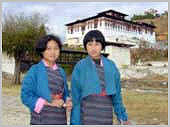
|
Taksang Monastery
It is said that Guru Rinpoche (Precious Master),
the father of the Bhutanese sect of Mahayana
Buddhism, arrived in Paro Valley more than a
millennium ago on the back of a legendary tigress.
He meditated for three months in a cave where
a monastery was later built and called Taktsang
Lhakang or Tiger's Nest Visitors
to Paro can take a closer look
|
at
the monastery by ascending either on foot or
by pony for about three hours to Tiger's Nest.
Walkers can enjoy a rest at the Taktsang Teahouse
situated at a wonderful vantage point overlooking
the monastery. On clear days you can get a clear
view of mount Chomolhari the sacred peak of
Bhutan. |
THIMPHU
VALLEY
Altitude: 2,350m / 7,710ft.
Thimphu is a small, charming capital city sandwiched
in the heart of the Himalayas. It sits in its
own valley fanning out from the river. The skyline
hardly changes as new buildings are all constructed
under zoning regulations. Thimphu's development
is strictly monitored and buildings cannot exceed
a certain height, nor can they be designed in
anything but the traditional Bhutanese style.
In fact, Thimphu's first and only traffic light
was enshrined in a chorten ! (a small
Buddhist temple). Not being suitable to the
nature of Thimphu, the traffic light was removed
on the King's orders. |
Only a sprinkling of cars
are found along the main street and the capital's
population is not immediately visible. But,
if you look inside the bank or the shop, you
will find Thimphu's people and Bhutan's heart.
Dressed in gho or kira (a wrap-around
robe), Thimphu people go about their work methodically,
quietly bringing their nation through the growing
pains of development and into its own definition
of the modern world.
|
|
Simtokha
Dzong, six kms from the city
limits,
is the kingdoms
oldest dzong which is now used as the Dzongka
language school of Bhutan. Bhutan's most stately
and arguably most impressive building is Tashichhodzong,
on the banks of the Wangchu (Thimphu River).
The home of the National Assembly and the summer
residence of the capital's venerated monastic
community, Tashicchodzong is a palatial building
overlooking the river on the South side and
the city of Thimphu from the North. While foreign
visitors are only allowed to enter Tashicchodzong
during the annual festival, its presence and
its exterior and grounds provide a delightful
spectacle. The dzong is the impressive result
of a redesign of the original medieval structure
sanctioned by the Third King, HM Jigme Dorje
Wangchuck, when he moved Bhutan's permanent
capital to Thimphu.
One of the most enjoyable ways of passing time
in Thimphu is wandering through the town. Full
of wonderful restaurants and delighful shops
stocked with items from all over Bhutan. Hand
woven textiles, woodcarving, tailor made clothing,
jewelry. Thimphu's weekend market is
another chance to watch the way life in the
kingdom. Here, every weekend, Thimphu's residents
break from whatever it is that they are doing
to stock vegetables, a copy of Kuensel (the
weekly newspaper) and to exchange the week's
gossip. For visitors who can't share in the
gossip, a wander through the stalls reveals
mountains of bright red chilies, eggplants and
okra, asparagus in season and rice of many types.
Traditional Bhutanese masks, incense, hand made
knives, jewelery are also sold here. It's an
incredible experience for the visitor.
Another of Bhutan's loveliest exports is its
wide and diverse collection of stamps. These
are best seen in commemorative books at Thimphu's
central post office. Other places of interest
in Thimphu include the traditional painting
school where the age-old styles of Bhutanese
painting, including thangka painting, are taught
and the Memorial Chorten build in memory
of His Majesty, the Third King of Bhutan. The
National Library houses a vast collection of
books and research documents of Buddhist studies.
|
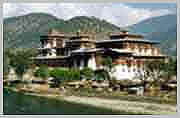
|
PUNAKHA
VALLEY
Altitude: 1,310m / 4,300ft.
The first stop after leaving Thimphu on the
journey east is Dochu La (la means pass)
at 10.007ft. Only an hour's drive from Thimphu,
it offers visitors their first glimpse of the
Eastern Himalayan range. The best time to reach
Dochu La is early morning when the mountain
views are clear and one can enjoy a spectacular
panoramic views of the Bhutanese Himalayas. |
From the pass the road curls its way down into
the relative lowlands of the Punakha Valley.
Before Thimphu was made the permanent capital
of Bhutan, Punakha was the Winter Capital because
of its more temperate climate. The Je Khenpo
(leader of Bhutan's religious order) and his
council of monks still come to pass the Winter
months here.
Punakha Dzong was strategically built at the
confluence of the Pho Chu (male) and Mo Chu
(female) rivers by the first Shabdrung
of Bhutan, Ngawang Namgyel in 1637. It has been
damaged by four fires and an earthquake in 1897
and has been devastated by flood water coming
from the great northern glaciers. The Dzong
has now been fully restored to its original
splendor.
|
WANGDUE
PHODRANG
Altitude:
1,310m / 4,300ft.
Wangdue Phodrang is the last westerm town on
the highway before central Bhutan. Wangdue Phodrang
(or Wangdue) is a typical small Bhutanese town.
It has a bustling market with well stocked shops
and a pretty view of the valley and dzong.
|
|
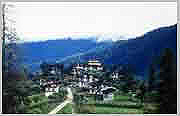
|
PHOBJIKA
VALLEY & GANGTEY GOMPA
Altitude: 2,900m / 9,510ft.
A few hours' drive from Wangdue Phodrang is
Phobjika valley. Here also is Gangtey Gompa,
a monastery dating back to the 17th century.
This short journey south from the main East-West
artery is well worth the detour for the dramatic
change of scenery. The
|
|
monastery is inhabited only
in summer months. Spotting black-necked cranes
in the meadows of the valley floor is an ornithologist's
dream come true. These rare birds migrate from
the high plains of the Tibetan plateau in Winter
to the milder climate of Phobjika. |
PHUENTSHOLING
Altitude:
300m / 985ft.
Popularly known as the 'Gateway to Bhutan',
Phuentsholing is a vibrant town located adjacent
to the Indian border town of Jalpaiguri, a district
of the Indian state of West Bengal. The town
is a bustling commercial centre providing a
glimse of Indian merchants and Bhutanese dressed
in traditional khos and kiras.
The climate of Phuentsholing contrasts greatly
with the higher land of Bhutan. It is tropical,
hot and humid during the summer, and warm and
pleasant in the winter. It is located 180 km
from Thimphu and is about a six hours drive.
Phuentsholing is the only other entry/exit point
to Bhutan other than the airport at Paro. The
closest Indian domestic airport is at Bagdogra,
about 160 km from the Bhutanese boarder, which
is connected by daily flights to Delhi and Calcutta. |
CENTRAL
BHUTAN
The Black Mountains separate
Western Bhutan from Central Bhutan. This region
includes Trongsa and the rich broad valleys
of Bumthang including Chumey, Choekar, Tang
and Ura valleys. The passes crossed are Yotang
La (3425m, 11,237ft.) and Thrumsing La
(3780m, 12,402ft.). Central Bhutan is known
for its buckwheat and apple production, its
sturdy stone houses, and its plethora of monasteries.
Its the ideal place for walking due to its broad
valleys and sloping mountains. The beauty of
the Bumthang valley is legendary. Below are
described the main areas of Central Bhutan.
|
|
TRONGSA
Altitude: 2,200m / 7,215ft.
Crossing the Black Mountains which separate
western and central Bhutan, you'll enter a part
of the country which until the l970's was only
reached by mule and foot trails. The mountain
road passes through deciduous forests and at
the second pass, Pele La, the entire
area is blanketed by high altitude dwarf bamboo.
About five miles from Trongsa, the road winds
around a cliff to a viewpoint looking down onto
the settlement of Trongsa. The view is one of
the most beautiful sights in all Bhutan and
one from which you may remember for a long time.
Sloping down the contours of a ridge stands
the many-leveled Trongsa Dzong, built
in 1648. It takes at least another 40 minutes
from the look-out before you arrive in Trongsa
proper. The dzong acts as a defensive fortress,
and its bright golden yellow roof occupies most
of the view from Trongsa. Trongsa is the ancestral
home of the Royal Family. The Crown Prince of
Bhutan traditionally becomes "Penlop" (Governor)
of Trongsa before being crowned King.
Trongsa
Dzong was built in 1648 and has been the traditional
home of all four kings of Bhutan prior to their
ascending the throne.
Trongsa's location in the geographic center
of the kingdom has enabled a "Penlop"
(Governor) to effectively control the entire
East and West of the country from there. Ta
Dzong, the watch tower, which once guarded the
Dzong from internal rebellion, stands impressively
above the Dzong and provides visitor with some
insight into the historical significance of
Trongsa in Bhutan's history.
|
BUMTHANG
VALLEYS
Continuing past Trongsa you'll travel over two
spectacular passes into the Bumthang Valley,
often compared to Switzerland. The terrain changes
quickly from rhododendron forests to conifers.
The first valley, Chumey (2,700m / 8,860ft.)
is a wide fertile valley where wheat, barley,
potatoes and buckwheat are cultivated. It is
also known for it's famous wool weaving called
"Bumthang Yathra".
Continuing we
enter the Bumthang Valley consisting of the
Choekar (West), Jakar and Tang (East) Valleys.
With the main town of Jakar serving as its capital.
|
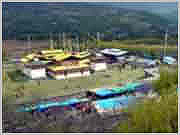
|
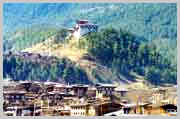
|
JAKAR
Altitude: 2,800m / 9,185ft.
The hills around Jakar are filled with monasteries
dedicated to Guru Rinpoche (Padmasambhava)
who is said to have cured an ailing ruler and
introduced Buddhism to the valley. Bumthang
is also home to one of the great Buddhist teachers,
Pema Lingpa, to whose descendants the
present dynasty traces its origins. Pema Lingpa
|
was
a blacksmith who was led by mystic forces to
discover spiritual treasures (termas)
placed by Guru Rinpoche at the bottom of Mebartsho
or Flaming
Lake. Not knowing how
to impart
the knowledge contained in the treasures he
hid until one day the Dakinis, or female
heavenly spirits, showed him the power of preaching.
Legend explains
that as he spoke, flowers dropped from the
sky and vanished into rays of light. Jambay
Lhakang Drub Monastery is host to one of
the most spectacular festivals in October each
year when on one evening of the festival, the
monastery is lights up with a fire dance to
bless infertile women with children. No where
else in Bhutan will you see as many temples
and monasteries in such a confined area. |
URA
Altitude: 3,100m / 10,170ft.
The easternmost valley, Ura, is also the highest
in Bumthang. Wide open spaces characterizes
the valley that sits in the shadow of the Thrumsing
La pass, separating the East from the West
of the kingdom. Ura village and its new monastery
are a charming stop before the climb to the
east. Cobbled streets and a medieval feel give
Ura an unusual yet very attractive atmosphere.
The old women of Ura still wear sheepskin shawls
on their backs which double as a blanket and
cushion. |
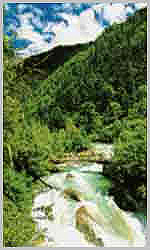
|
EASTERN
BHUTAN
This region comprises Mongar, Lhuentse, Trashigang
and Trashi Yangste. Passes crossed are Rodang
La and Narphung La both at much lower altitudes
than passes in Western and Central. The forests
dissipate and the altitude is lower. The warmer
climate is suitable for growing corn, rice,
wheat, potatoes and surprisingly lemon grass.
Eastern Bhutan is known for its stunning hand-loomed
textiles and the weavers are all masters of
the "supplementary weft-weave" technique.
Eastern Bhutan is the least travelled area of
the country. Below are described the main areas
of Eastern Bhutan. |
|
MONGAR
Altitude:
1,700m / 5,580ft.
The differences between Eastern and Western
Bhutan are far greater than the high pass that
separates them. Perhaps like the Scots and the
English, there are subtle but marked differences.
History has played a significant role with the
kingdom only being unified with the east at
the end of the last century. Prior to that many
wars separated each side.
The eastern dialect is so different from the
western dialect that the two groups find it
difficult to understand each other. Thrumsing
La and a seven-hour drive separates Ura
from Mongar in the East. The journey is one
of the most beautiful in all the Himalayas.
Rising out of Ura, the highway climbs steeply
to the highest pass (3,800 meters, 12,800 ft.)
along the West-East highway at Thrumsing La
(during the Winter the pass can be closed for
several days after snowfalls) where the mountains
of east Bhutan can be seen during clear weather.
The descent from Thrumsing La to Lingmithang
is astonishing for several reasons. The road
drops from 3,800 meters to a mere 650 meters
in only a few hours passing from pine forest
through semi-tropical forest and orange groves.
Carved out of the side of the mountain, here
the road follows a sheer cliff face 1000 feet
above the valley floor. Arriving at Mongar marks
the beginning of your eastern Bhutan experience.
Towns in eastern Bhutan are built on the sides
of the hills which contrasts to valley floor
settlements in the west. Mongar Dzong was built
in 1953 on the orders of the Third King, Jigme
Dorje Wangchuck. The Royal Guesthouse is located
near the dzong enjoying a pleasant view from
the garden over Mongar Valley. Some of the finest
weaving villages in Bhutan are found in the
Mongar area.
|
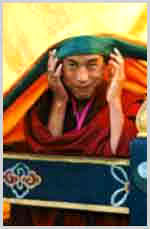 |
TRASHIGANG
Altitude: 3,773m / 12,375ft.
Trashigang is the eastern-most point on the
highway. Eastern residents use Trashigang to
trade and the town itself is usually a hive
of activity, especially around the bus station
where buses are frequently leaving for Thimphu
and Paro in the west and Samdrup Jongkhar and
India, only a few hours to the southeast. A
short distance is Radhi considered one
of Bhutan's most renowned weaver villages. Trashigang
is also a melting pot of hill tribe people who
come to the town to trade. The villagers
of the remote Merak and Sakteng areas
come to Trashigang to trade yak's butter for
the provisions that they need in the mountains.
Merak and Sakteng are located about 50 miles
east of Trashigang close to the border with
India's Arunachal Pradesh.
|
Trashigang Dzong sits on a jagged piece
of land jutting out from the town and is the
first landmark that can be seen from the road
winding up to Trashigang. The Dzong was built
in 1659 and commands a spectacular view over
the valley for which it is the administrative
center. The Dzong is significant for the fact
that it only has one courtyard. |
TRASHI
YANGSTE
Altitude: 1,850m / 6,070ft.
On the drive to Trashi Yangtse you pass the
small town of Duxsum located on the Drangme
Chhu and its tributary. It is a few kilometers
past Gom Kora. A large boulder sits in the garden
of Gom Kora (Gomphu Kora) Temple and
it is said that if anyone can climb below the
rock and emerge from its summit, he will be
forgiven of his sins. Duxsum is a small weaver's
town where you can find a fair amount of weavers
producing some very nice work. The landmark
of the town is a original iron chain suspension
bridge built by Thangtong Gyalpo or Lama
Hazampa (Lama Iron-bridge) in the 1600's.
Duxsum is the main supply town for all the high
mountain villages that surround it.
Trashi Yangtse is a small town and a
lovely place from where the visitor can launch
a hike into the surrounding countryside. Chorten
Kora is one of the only two such stupas
in Bhutan with styles similar to those found
in Nepal and is host to a great festival every
March which attracts all of eastern Bhutan's
residents. The Chorten is entirely whitewashed
and ideally situated next to a running brook.
Trashi Yangste is also famous for its hand made
wooden bowls and cups used all over the country.
The finest are made from rhododendron burl.
|
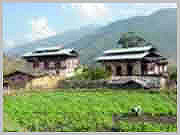 |
SAMDRUP
JONGKHAR
The road from Trashigang to Samdrup Jongkhar
was completed in the early 1960s and enables
the eastern parts of the kingdom to access and
benefit from trade with the south as well as
across the border into India. It is possible
to drive from Samdrup Jongkhar to Phuentsholing,
the eastern border town, via Assam and West
Bengal
|
|
of India. From
Trashigang the road descends through thick jungle
before arriving at the border town of Samdrup
Jongkhar. The town is no more than a frontier
post with a couple of hotels and restaurants. Visitors
can exit Bhutan from Samdrup Jongkhar, instead
to driving back all the way back to Paro or
Phuentsholing. Guwahati airport in India
is located about 100 km from the border and
from there there are daily flights to Calcutta
and Delhi. |
|
|
|
BHUTAN TREKKING |
BHUTAN CULTURAL TOURS |
BHUTAN FESTIVAL TOURS |
HIMALAYAN TOURS |
|
...
|
...
|
...
|
|
|
|
|
|
|
|
|
|
|
|
|
|
|
|
|
... |
|
... |
|
... |
|
... |
...
|
... |
|
|
|
